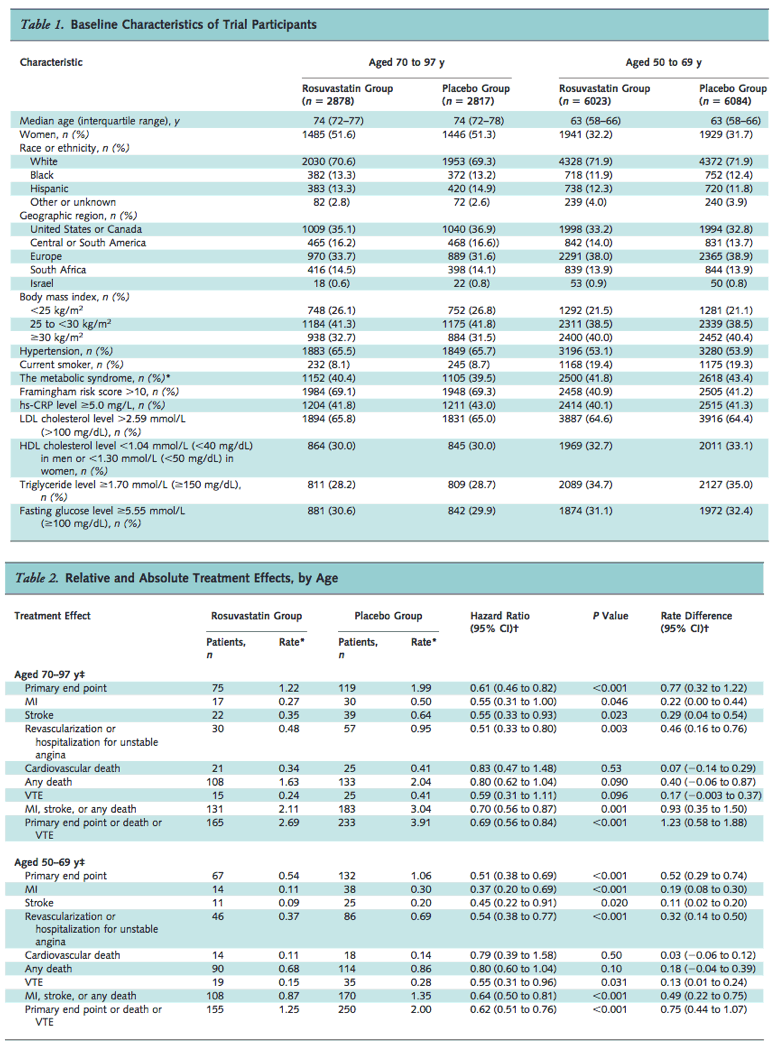| |
Statin (JUPITER study) in Elderly with Relatively Low Risk Factors
|
| |
| |
These persons were identified as men 50 years or older and women 60 years or older without diabetes or a history of myocardial infarction, stroke, arterial revascularization, or coronary artery disease equivalent by National Cholesterol Education Program guidelines and with low-density lipoprotein (LDL) cholesterol levels less than 3.37 mmol/L (130 mg/dL), triglyceride levels less than 5.65 mmol/L (500 mg/dL), and high-sensitivity C-reactive protein levels of 2 mg/L or more (6).
Rosuvastatin for Primary Prevention in Older Persons With Elevated C-Reactive Protein and Low to Average Low-Density Lipoprotein Cholesterol Levels: Exploratory Analysis of a Randomized Trial - (04/26/10)
Taken in the context of a post hoc analysis, the magnitude of cardiovascular event reduction associated with rosuvastatin was impressive in older persons.
Results: The 32% of trial participants 70 years or older accrued 49% (n = 194) of the 393 confirmed primary end points. The rates of the primary end point in this age group were 1.22 and 1.99 per 100 person-years of follow-up in the rosuvastatin and placebo groups, respectively (hazard ratio, 0.61 [95% CI, 0.46 to 0.82]; P < 0.001). Corresponding rates of all-cause mortality in this age group were 1.63 and 2.04 (hazard ratio, 0.80 [CI, 0.62 to 1.04]; P = 0.090). Although no significant heterogeneity was found in treatment effects by age, absolute reductions in event rates associated with rosuvastatin were greater in older persons. The relative rate of any serious adverse event among older persons in the rosuvastatin versus placebo group was 1.05 (CI, 0.93 to 1.17).
Statins for Primary Prevention in Older Adults: Who Is High Risk, Who Is Old, and What Denotes Primary Prevention? Editorial - (04/26/10)
As atherosclerosis increases with age in most but not all older persons, we need methods to discern which older adults with atherosclerosis are at the greatest risk for cardiovascular events.
JUPITER was designed to determine the efficacy of rosuvastatin versus placebo for primary prevention of cardiovascular events in healthy older persons. These persons were identified as men 50 years or older and women 60 years or older without diabetes or a history of myocardial infarction, stroke, arterial revascularization, or coronary artery disease equivalent by National Cholesterol Education Program guidelines and with low-density lipoprotein (LDL) cholesterol levels less than 3.37 mmol/L (30 mg/dL), triglyceride levels less than 5.65 mmol/L (500 mg/dL), and high-sensitivity C-reactive protein levels of 2 mg/L or more (6). Despite average to low LDL cholesterol levels, these persons were considered to have high vascular risk because of elevated high-sensitivity C-reactive protein levels (7). Baseline Framingham risk score was not provided for the overall JUPITER cohort. In this substudy, almost 70% of persons had a Framingham risk score greater than 10%, and given their age and prevalence of hypertension (>65%), many probably had a Framingham risk score greater than 20%; by National Cholesterol Education Program guidelines, these persons should receive aggressive treatment. The benefit of rosuvastatin was absent for the subgroup without hypertension. Whether high-sensitivity C-reactive protein levels add additional information to risk prediction in older persons is also controversial because high-sensitivity C-reactive protein levels increase with age (8, 9). This increase may reflect, in part, an upregulation of inflammatory pathways and oxidative stress, increases due to comorbid conditions, or both.

|
|
| |
| |
|
|
|